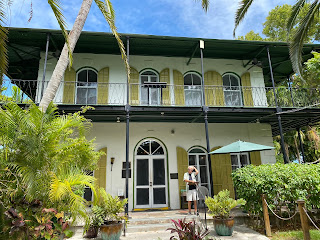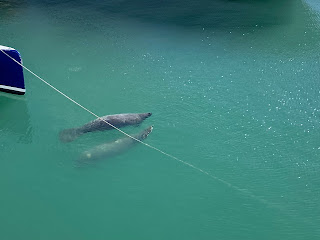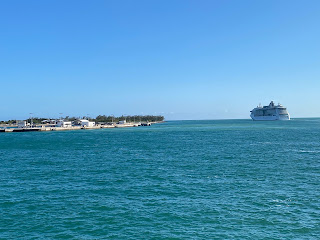Off on a big adventure today - going to Key West! Key West is an island in the Straits of Florida. The island of Key West is roughly 4 miles (6.5 kms) long by 1 mile (1.6 kms) wide with a population of approximately 26,000. It’s about 90 miles from Key West to Cuba - it’s closer to Cuba than it is to Miami.
Key West has a history that dates back to the early 1800’s, if not earlier, but it remained relatively isolated until 1912, when it was connected to the Florida mainland via the Overseas Railway. After the railway was destroyed by a hurricane in 1935 the U.S. government rebuilt the rail route as an automobile highway, completed in 1938, built atop many of the footings of the railroad.
My adventure today began in Fort Myers. The only way to drive to Key West would have been to cross the state of Florida to Miami and then take U.S. Route 1 around the southern end of the state and across the Florida Keys to Key West, a journey that would have taken approximately 7-8 hours to drive. Instead we drove to Fort Myers where we caught the express, high-speed ferry that goes straight south, though the Gulf of Mexico, and gets to Key West in about three hours. So still a bit of travel time involved but that was okay - how could being on a boat in the Gulf of Mexico on a beautiful weather day not be okay??!!
The Key West Express ferry left from Matanzas Harbour, part of the inter coastal waters at Fort Myers. It was an early morning start so I was there for sunrise.
7:02am - first glow of daylight
7:09am, no sun yet, but closer to sunrise
7:32am - you can see the sun just about to show itself behind the building.
Now the same timeline but looking in the other direction. 7:04am as the sky is just starting to lighten.
7:07am - I like the reflections
7:17am
7:24am - the same pre-sunrise pink sky that I get in Bayfield
My friends (and I) - staking out our seats on the upper deck in the pre-dawn.
Matanzas Pass Bridge - linking the mainland (Fort Myers) to San Carlos Island (where the ferry leaves from), to Fort Myers Beach (which the ferry will pass by).
It’s a bit hard to see in the photos - but what I was keenly aware of was just how much damage could still be seen after Hurricane Ian. 6 months later and still many businesses closed, boats lodged in buildings and in parking lots, and destroyed buildings and houses where rebuilding has yet to begin.
When we came back at night this whole area was dark - none of these buildings have electricity restored yet. It was very weird to see!
Out on the Gulf - the skyline of Fort Myers just a spec in the distance.
It appears as if no one but Canadians were hardy enough to brave the upper deck! I can’t deny it was pretty windy (perhaps that’s a bit of an understatement!) but it wasn’t super cold.
Taken by one of my friends - me battling the wind while walking.
Basically three hours with the water, sky/clouds and the occasional rainbow to watch.
The first sighting of land - some of the uninhabited islands, west of Key West, that are part of Key West National Wildlife Refuge.
And then finally, Key West itself.
Key West is a port of call for many cruise ships, including this one, the Brilliance of the Seas, that was here today.
One of many harbour areas around Key West - this one is Key West Bight, near where the ferry docks.
After what was originally a church building and having been burned to the ground twice, this building (built in the late 1950s) is now the Key West Theatre - a soft pink building with bright turquoise Miami-reminiscent details.
Constructed in 1892, this is one of only a few historic homes in Key West not built of wood. The Key West Woman’s Club (established in 1915) purchased it in 1940 and founded and maintained Key West’s first public library in this building.
This building was the first office, the birthplace, of Pan American World Airlines. On Oct. 28, 1927 Pan American flight No. 1 taxied down a runway in Key West bound for Havana. This was the first United States international air service in scheduled operation.
The James J. Curtis House - built in 1874 as a private home. In 1913 it became the marine officer’s headquarters.
A naval station was established here in 1823 and remained in constant operation until its disestablishment in 1974. Although its function varied over the years, it operated through seven conflicts with its personnel reaching from a low of 17 military in 1932 to over 15,000 military and 3000 civilians in 1945.


The tropical weather was the reason why Key West was chosen as the site of President Harry S. Truman’s Winter White House. President Truman established a working vacation home here, and he spent 175 days of his presidency at the Little White House. Although not now, the house was originally waterfront when built in 1890 as the first officer’s quarters on the U.S. naval station. In 1911 the building was converted into a single-family home, additional land was filled in front of the house, and then the waterfront view was eventually blocked by a new building on the station. Prior to Truman establishing it as a ‘formal’ working space, Presidents Taft and Edison also stayed in the house, and after Truman, Presidents Eisenhower, Kennedy, Carter and Clinton also spent time here. Additionally, Secretary of State Colin Powell held a week of peace talks here in 2001.


This 1950 Lincoln Cosmopolitan stretch limo is one of nine limousines staged at various cities throughout the United States for use by President Truman.
Key West lies at the southernmost end of U.S. Route 1, the longest north-south road in the United States.
This is an incredible tree - a Kapok Tree. Kapok trees can grow up to 10 feet a year, reaching heights of 250 feet. They are beautiful trees, with wide buttresses at the base and large crowns of leaves and branches.
The Monroe County Courthouse, built in 1890
Earnest Hemingway (1899-1961), the great American novelist, short-story writer and journalist, lived in Key West during the 1930s. The house where Hemingway lived was built in 1851. It was a wedding gift to Ernest and his wife from his wife’s uncle, and the Hemingways restored the entire house.
The second storey of the carriage house was converted into a writing studio. During his years in Key West Hemingway wrote some of his best-received works, including the non-fiction work Green Hills of Africa (1935), the 1936 short stories The Snows of Kilimanjaro and The Short Happy Life of Francis Macomber, and the novels To Have And Have Not (1937) and Islands in the Stream (discovered and published posthumously in 1970).

This unusual ‘fountain’ on the grounds of the Hemingway house has an interesting story. Hemingway spent so much time at his friend, Joe’s, bar, that when Joe was moving locations Hemingway remarked that surely he’s spent enough money there to own a small chunk of it. Joe laughed and gifted him with one of the bar’s urinals. Pauline (Hemingway’s wife), upon finding a urinal in her yard, was unimpressed, but made the best of a bad situation by adorning the urinal with decorative tile. Hemingway then had the urinal, along with a large decorative Spanish olive jar that he’d brought from Cuba, fitted with plumbing and converted into a self-refreshing water fountain for his cats.

Almost immediately after the U.S. Navy established a base in Key West in 1823, the need for a lighthouse became evident. The first Key West lighthouse was a 65-foot tower completed in 1825. This Lighthouse opened in 1848 with a woman as its Keeper; nearly unheard of during the 19th century. In the following years the lighthouse was upgraded to include the installation of a Third Order Fresnel Lens (photo below). In 1969 the U.S. Coast Guard decommissioned the Key West Lighthouse and today it is a museum.
Looking out over Key West from the top of the lighthouse.
The Lighthouse Keeper’s Quarters, built in 1887.
This concrete structure was built in 1917. Its purpose was to protect the connection between the land line and the 125 mile long underwater telegraph cable lines linking Key West and Havana, Cuba. The first international phone call was made through similar cables in Key West on Christmas Day, 1900 when John W. Atkins called Cuba and after a long silence, Cuba answered quite simply “I don’t understand you”.
I couldn’t resist - after all, who knows if I’ll ever be here again. This large, painted, concrete buoy was erected in 1983 and other than some paint damage (that has been repaired by the original artist) it has withstood all hurricanes since then. It’s not completely accurate however although it is within the general ballpark.
This point here is technically the most southernmost point but it’s located on a U.S. Naval base and cannot be entered by civilian tourists.
Some of the southern coastline of Key West.
As if!!?? 🤣
Back in the marina again, and this time some manatees came to say hello to us…
…and saying hello to each other too!
Good-bye to Key West after a great day!
Sunset over the Gulf of Mexico
No clouds and a bit of a haze on the horizon, so not a ‘spectacular’ sunset but I certainly won’t complain. And there was some lovely afterglow - complete with a little crescent moon and Venus.
Again - only us Canadians on the upper deck. It was a great place to be … but I will admit that for a while I did appreciate the little cubby corner I discovered as a wind break.
Here’s the boat that took me on my journey through the Gulf of Mexico, to and from Key West. It’s a 170 foot catamaran, with three decks of indoor and outdoor seating. It cruises though the Gulf waters at more than 30 knots (more than 40 mph). It was a great trip!!




















































































No comments:
Post a Comment